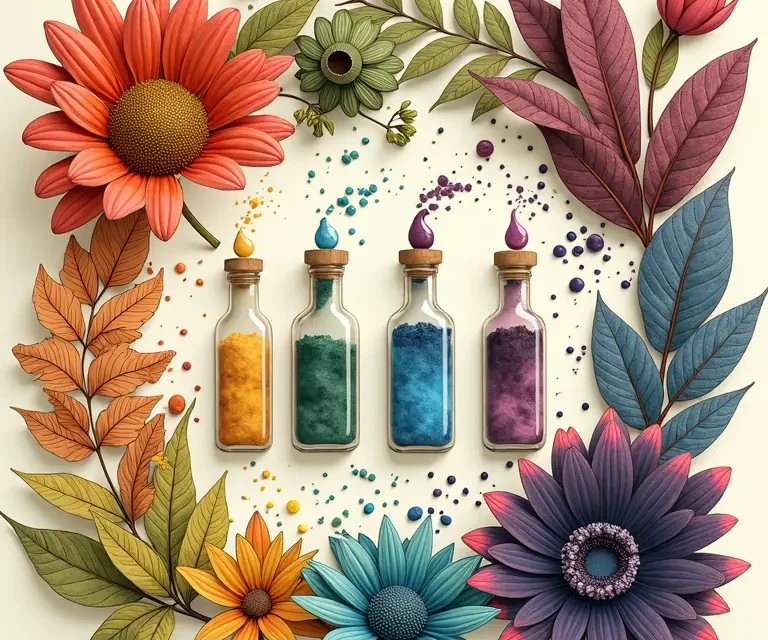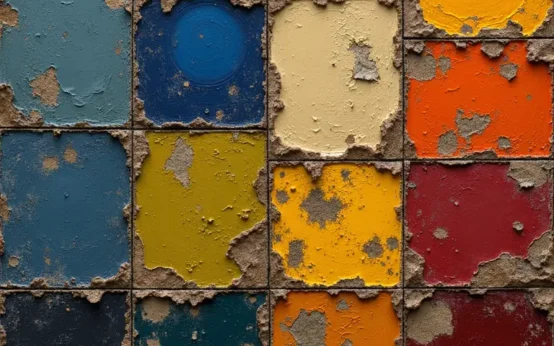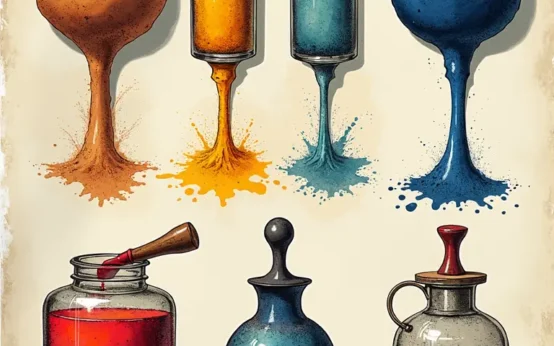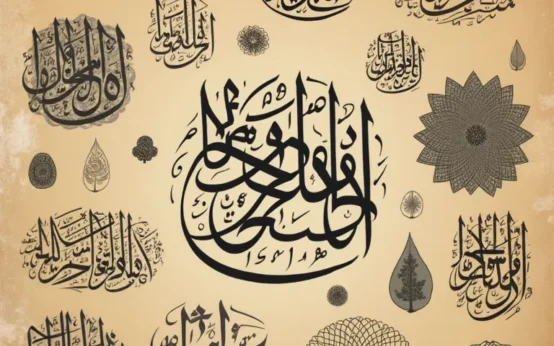For millennia, humans have adorned themselves and their surroundings with color. Long before the advent of synthetic dyes, vibrant hues were coaxed from the natural world – plants, animals, minerals, and even microorganisms. What’s often overlooked is that the processes used to create these dyes weren’t simply based on intuition or tradition; they were, and continue to be, underpinned by surprisingly consistent scientific principles. This article will explore the chemistry and techniques behind historical dye recipes, demonstrating how ancient artisans, often unknowingly, applied concepts of solubility, pH, mordanting, and oxidation-reduction reactions to achieve remarkably stable and reproducible colors. We’ll journey from the earliest evidence of textile dyeing to the modern revival of natural dyeing techniques, highlighting the enduring relevance of these time-tested methods.
Early Beginnings: Evidence and Ancient Techniques
The earliest evidence of textile dyeing dates back to the Neolithic period, around 6000 BCE, with fragments of dyed flax found in a cave in Sakharim, Georgia. These early dyes were likely derived from readily available plants, using simple boiling or fermentation methods. Archaeological discoveries in Egypt, dating back to the Predynastic period (before 3100 BCE), reveal the use of red ochre and other mineral pigments for body painting and textile decoration. The Egyptians were particularly adept at using madder root (Rubia tinctorum) for red dyes, and indigo (Indigofera tinctoria) for blue, although achieving a true, stable indigo blue proved more challenging initially.
Ancient dyeing techniques, while varying geographically, shared common principles. Many involved prolonged heating of the dye source in water, often with the addition of alkaline or acidic substances to modify the color or improve its fastness. Fermentation also played a role, as seen in the production of Tyrian purple (see below). However, a crucial element often missing from these early methods was the use of mordants – substances that help the dye bind to the fiber. Without mordants, dyes tended to wash out easily, limiting the durability of the colors.
The Rise of Tyrian Purple: A Chemical Masterpiece
Perhaps the most iconic dye of the ancient world is Tyrian purple, a vibrant, reddish-purple color associated with royalty and power. Produced by the Phoenicians (and later the Romans) from the mucus secretion of marine snails (specifically Murex brandaris and Hexaplex trunculus), Tyrian purple was incredibly expensive and labor-intensive to produce. The process involved collecting thousands of snails, crushing their shells, and extracting a small amount of a colorless precursor chemical. This precursor was then exposed to sunlight, triggering a complex series of oxidation reactions that yielded the characteristic purple dye.
The chemistry of Tyrian purple is surprisingly sophisticated. The key intermediate is dibromoindoxyl, which, upon exposure to UV light and oxygen, undergoes a rearrangement to form indigoid dyes – the same structural class as indigo. The exact shade of purple varied depending on the species of snail used, the duration of exposure to sunlight, and the presence of other compounds. The Romans, recognizing this variability, developed methods to control the process and produce consistent shades. This demonstrates an early understanding of chemical kinetics and reaction control, even if the underlying principles weren’t explicitly articulated.
Indigo: From Leaf to Vat
Indigo, arguably the most important blue dye in history, has a fascinating story. While evidence of indigo use dates back to ancient Egypt, its widespread adoption came later, particularly in India, where it was cultivated and processed for centuries. The challenge with indigo lies in its insolubility in water. Simply boiling indigo leaves doesn’t yield a blue dye; instead, it produces a greenish-yellow solution. To unlock the color, a process called “vatting” is required.
Vatting involves reducing indigo (oxidized form) to leuco-indigo (reduced, soluble form) using a reducing agent such as lime, wood ash, or iron filings. This creates a vat of greenish-yellow solution. When the fabric is immersed in this vat, the leuco-indigo penetrates the fibers. Upon exposure to air, the leuco-indigo oxidizes back to insoluble indigo within the fibers, creating a permanent blue color. This oxidation-reduction process is a fundamental chemical principle that has been consistently employed in indigo dyeing for thousands of years.
Madder: The Red Spectrum
Madder, derived from the roots of the Rubia tinctorum plant, provides a range of red shades, from bright scarlet to deep burgundy. The active dye components in madder are primarily alizarin and purpurin, along with smaller amounts of other anthraquinone derivatives. The color obtained from madder is heavily influenced by the mordant used. Aluminum mordants produce brighter reds, while iron mordants yield darker, more brownish-red shades. Tin mordants can produce vibrant scarlets.
The use of different mordants isn’t arbitrary; it’s a direct result of the chemical interactions between the metal ions in the mordant and the dye molecules. The metal ions form complexes with the dye, altering its light absorption properties and, consequently, its color. This principle of coordination chemistry was unknowingly applied by ancient dyers, who observed that different metals produced different results and refined their techniques accordingly.
Woad: A European Alternative to Indigo
Before indigo became widely available in Europe, woad (Isatis tinctoria) was the primary source of blue dye. Woad contains indoxyl glucoside, a precursor to indigo. The process of extracting blue from woad is similar to indigo vatting, involving fermentation and reduction to create a leuco-dye that can be applied to textiles. However, woad generally produces a less vibrant and less wash-fast blue than indigo, which ultimately led to its decline in popularity once indigo imports increased.
The Impact of Mordants: A Deep Dive
As mentioned previously, mordants are critical for achieving durable and vibrant colors with natural dyes. They work by forming a bridge between the dye molecule and the fiber, preventing the dye from washing out. Common mordants include alum (potassium aluminum sulfate), iron sulfate, tin chloride, and copper sulfate. Each mordant interacts differently with the dye, altering its shade and fastness properties.
Alum is a versatile mordant, generally producing bright, clear colors. Iron sulfate tends to “sadden” colors, creating more muted or darker shades. Tin chloride can produce brilliant, but often less lightfast, colors. Copper sulfate yields greenish or olive tones. The choice of mordant is therefore a crucial decision in the dyeing process, dictating the final result. Understanding the chemistry of these interactions—the formation of coordination complexes, the alteration of dye molecule structure—is key to successful natural dyeing.
The Scientific Revival of Natural Dyeing
In recent decades, there has been a resurgence of interest in natural dyeing, driven by concerns about the environmental impact of synthetic dyes and a desire to reconnect with traditional crafts. This revival has been accompanied by a more scientific approach to understanding the underlying principles of natural dyeing. Researchers are now analyzing the chemical composition of dye plants, investigating the mechanisms of dye-fiber interactions, and developing methods to improve dye fastness and reproducibility.
Modern analytical techniques, such as spectrophotometry and chromatography, are used to characterize dye molecules and monitor the dyeing process. Studies have shown that the historical recipes, while often imprecise in their measurements, were remarkably effective in achieving consistent results, demonstrating a deep understanding of empirical observation and practical knowledge. Furthermore, research is exploring the potential of using natural mordants and sustainable dyeing practices to minimize the environmental footprint of textile production.
Beyond Textiles: Pigments and Paints
The principles of historical dye recipes extend beyond textile dyeing to the creation of pigments for paints and other applications. Mineral pigments, such as ochre (iron oxides), malachite (copper carbonate), and azurite (copper phosphate), were used extensively in ancient art. The preparation of these pigments often involved grinding the mineral into a fine powder and mixing it with a binder, such as oil, egg yolk, or beeswax.
Organic pigments were also derived from plants and animals. For example, gamboge, a reddish-orange pigment, is obtained from the resin of the Garcinia cambogia tree. Carmine, a vibrant red pigment, is extracted from cochineal insects. The stability and color properties of these pigments depend on their chemical composition and the binder used. The same principles of solubility, oxidation-reduction, and complex formation that apply to textile dyes also govern the behavior of these pigments.
The Consistent Threads: Universal Scientific Principles
Throughout the history of dyeing and pigment production, several consistent scientific principles have emerged. These include:
- Solubility: Understanding which solvents dissolve the dye molecules is crucial for extraction and application.
- pH Control: Adjusting the acidity or alkalinity of the dyeing bath can influence the color and fastness of the dye.
- Mordanting: Using metal ions to form complexes with the dye and fiber, creating a stable bond.
- Oxidation-Reduction: Utilizing redox reactions to transform dye precursors into active coloring agents.
- Lightfastness & Washfastness: The chemical stability of the dye molecule and its interaction with the fiber determine its resistance to fading and washing.
These principles, while perhaps not explicitly understood by ancient artisans, were implicitly applied through observation, experimentation, and the transmission of knowledge across generations. The consistency of historical dye recipes, despite variations in local materials and techniques, is a testament to the universality of these underlying scientific principles. It’s a fascinating example of how practical knowledge can anticipate formal scientific understanding, and how traditions can embody surprisingly sophisticated chemical insights.
The study of historical dye recipes offers a unique window into the intersection of art, science, and culture. It demonstrates that even seemingly “traditional” practices are often grounded in fundamental scientific principles, and that the pursuit of color has been a driving force in human innovation for millennia. If you’re interested in exploring other areas where traditional practices reveal consistent scientific principles, consider looking into the geometry of origami, the physics of yo-yo tricks, or the science behind early fireworks.


 The Curious Science of Automaton Portraits: Likeness, Legacy, and Lost Art
The Curious Science of Automaton Portraits: Likeness, Legacy, and Lost Art  The Curious Chemistry of Lost Colors: Pigments, History, and the Art of Remembrance
The Curious Chemistry of Lost Colors: Pigments, History, and the Art of Remembrance  The Surprisingly Consistent Science of Ink Formulation: From Sepia to Modern Pigments
The Surprisingly Consistent Science of Ink Formulation: From Sepia to Modern Pigments  The Unexpectedly Precise History of Calligraphy – From Sacred Texts to Modern Art
The Unexpectedly Precise History of Calligraphy – From Sacred Texts to Modern Art